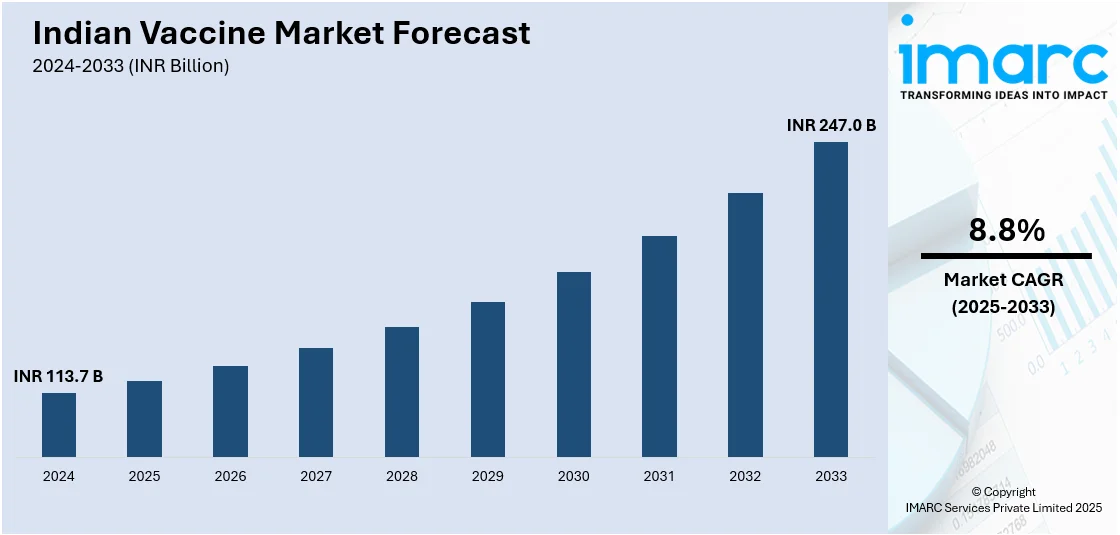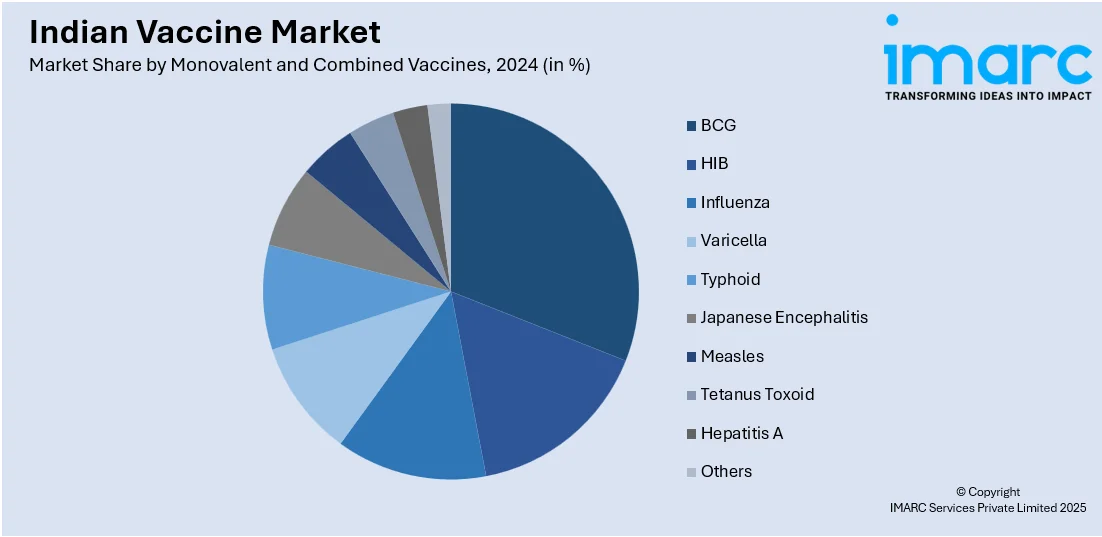
Indian Vaccine Market Size, Share, Trends and Forecast by Monovalent and Combined Vaccines, and Region, 2025-2033
Indian Vaccine Market Size and Share:
The Indian vaccine market size was valued at INR 113.7 Billion in 2024. Looking forward, IMARC Group estimates the market to reach INR 247.0 Billion by 2033, exhibiting a CAGR of 8.8% from 2025-2033. Indian vaccine market share is driven by the increasing emphasis on preventive healthcare, supported by government immunization programs, rising public awareness, and improved healthcare access. Growing demand for affordable vaccines and advancements in technology are also encouraging innovation and production, boosting overall vaccine uptake across various population segments.
|
Report Attribute
|
Key Statistics
|
|---|---|
|
Base Year
|
2024
|
|
Forecast Years
|
2025-2033
|
|
Historical Years
|
2019-2024
|
|
Market Size in 2024
|
INR 113.7 Billion |
|
Market Forecast in 2033
|
INR 247.0 Billion |
| Market Growth Rate 2025-2033 | 8.8% |
A key driver in the Indian vaccine market is the growing focus on preventive healthcare. With increasing awareness about disease outbreaks and the long-term benefits of immunization, both government and private stakeholders are prioritizing vaccination as a cost-effective public health tool. The expansion of awareness campaigns, school-based programs, and healthcare worker outreach in rural areas is bolstering the Indian vaccine market growth. Additionally, the rise in lifestyle and infectious diseases has shifted consumer preference toward preventive measures. This shift, coupled with strong government support and improved healthcare infrastructure, is significantly accelerating vaccine uptake across various age groups and socio-economic segments in India.

To get more information on this market, Request Sample
India’s shifting population structure marked by a growing base of children and an expanding elderly population is driving sustained demand in the Indian vaccine market outlook. With one of the world’s largest pediatric populations, routine childhood immunizations remain a cornerstone of healthcare priorities. Simultaneously, an aging demographic is increasingly vulnerable to diseases like influenza, pneumococcal infections, and shingles, prompting rising adult and geriatric vaccination needs. Government and private healthcare providers are introducing targeted immunization schedules to address these segments, backed by improved healthcare access and urbanization. This demographic-driven demand ensures consistent consumption across age groups, creating long-term market stability and encouraging new product development tailored to age-specific immunity requirements.
Indian Vaccine Market Trends:
Rising Government Initiatives and Immunization Programs
Government-led vaccination initiatives, such as Mission Indradhanush and the Universal Immunization Programme (UIP), continue to be pivotal in advancing India's vaccine market share. These programs focus on equitable access, especially in underserved rural regions, by targeting millions of children and pregnant women annually. Strategic partnerships with global entities like WHO, UNICEF, and Gavi bolster outreach and financial support. The government’s emphasis on digital health under Ayushman Bharat has transformed vaccine tracking and cold chain logistics. By December 2024, over 711 million Ayushman Bharat Health Accounts (ABHA) had been created, enabling seamless integration of digital health records. Simultaneously, the National Immunization Schedule is being expanded to include newer vaccines like pneumococcal conjugate and rotavirus. Rising public health budgets further support broader immunization, disease prevention, and sustained Indian vaccine market growth.
Expansion of Private Sector and Domestic Manufacturing
India’s vaccine market is witnessing rapid domestic production growth, driven by the rising involvement of private pharmaceutical firms. Key manufacturers are significantly expanding capacity to meet growing global and domestic demand. Notably, India supplies about 60% of the world’s vaccine requirements, with Telangana’s life sciences ecosystem alone contributing nearly one-third of this output. The pandemic further accelerated investment in (R&D) and infrastructure, spurring the development of advanced vaccine platforms such as mRNA-based and intranasal vaccines. India’s cost-effective manufacturing has also attracted international collaborations, reinforcing its role as a preferred global supplier. Additionally, private players are diversifying their portfolios beyond childhood immunizations to include adult and travel vaccines, expanding market reach. These developments are enhancing vaccine accessibility, fostering innovation, and solidifying India’s position as a global hub for affordable, high-quality vaccine production.
Technological Innovation and Digital Health Integration
Technology is transforming the Indian vaccine market through innovations in development, delivery, and data management. Digital health platforms like CoWIN, launched during the COVID-19 vaccination drive, have showcased the potential of tech-enabled immunization logistics. Real-time data tracking, appointment scheduling, and digital certification have improved efficiency and transparency. Simultaneously, biotech advancements are fostering next-generation vaccines using mRNA, DNA, and vector-based technologies, enhancing efficacy and safety. Cold chain logistics are being strengthened using Intent of Things (IoT)-enabled monitoring systems to reduce spoilage and ensure quality. Artificial intelligence (AI) and data analytics are also being leveraged to forecast demand and manage distribution. This integration of technology is modernizing India's vaccine ecosystem, enabling better reach, precision, and responsiveness in immunization efforts.
Indian Vaccine Industry Segmentation:
IMARC Group provides an analysis of the key trends in each segment of the Indian vaccine market, along with forecast at the country levels from 2025-2033. The market has been categorized based on monovalent and combined vaccines.
Analysis by Monovalent and Combined Vaccines:

- BCG
- HIB
- Influenza
- Varicella
- Typhoid
- Japanese Encephalitis
- Measles
- Tetanus Toxoid
- Hepatitis A
- Rubella
- Diphtheria
- Tetanus, and Pertussis (DPT)
- Oral Polio Vaccine (OPV)
- MMR
- Rotavirus
- Hepatitis B
- Pneumococcal
- Meningococcal
- Rabies
- HPV
- Hexavalent
- Dengue vaccines
Based on the Indian vaccine market forecast, the pneumococcal vaccines account for the majority share in the Indian vaccine market due to their critical role in preventing severe bacterial infections such as pneumonia, meningitis, and sepsis, particularly among infants, young children, and the elderly. Their inclusion in the Universal Immunization Programme (UIP) has significantly increased public access and demand. High disease burden, combined with government efforts to reduce child mortality rates, has prioritized pneumococcal vaccination at a national level. Additionally, widespread awareness campaigns and healthcare worker outreach have improved vaccine penetration in rural and underserved regions. The growing adoption of conjugate vaccine formulations, which offer broader protection and longer-lasting immunity, further contributes to their dominance in both public health programs and private healthcare settings across India.
The Focus of the Analysis for Each Vaccine
- Vaccine Overview
- Historical and Current Market Trends
- Market Breakup by Prescriber
- Market Breakup by Public and Private Sector
- Market Outlook
Competitive Landscape:
The competitive landscape is characterized by a mix of established domestic players and emerging innovators, supported by strong government and institutional frameworks. Companies are focusing on expanding production capacity, enhancing cold chain logistics, and investing in research to develop advanced vaccine platforms, including mRNA and intranasal technologies. The market is also seeing increased competition in newer segments like adult immunization, travel vaccines, and combination vaccines. Export potential, especially to low- and middle-income countries, adds another layer of competition among manufacturers. Strategic collaborations with global organizations, public-private partnerships, and government procurement programs further bolstering the Indian vaccine market demand. Overall, competition is driven by cost-efficiency, innovation, regulatory compliance, and the ability to scale rapidly to meet both domestic and international demand.
The report provides a comprehensive analysis of the competitive landscape in the Indian vaccine market with detailed profiles of all major companies, including:
- GlaxoSmithKline
- Sanofi Aventis
- Serum Institute of India
- Panacea Biotec
- Pfizer
- Novartis
- VHB Lifesciences
- Zydus Cadila
- MSD
Latest News and Developments:
- November 2024: Germany-based Boehringer Ingelheim launched its newest poultry vaccine in India to safeguard chicks against Marek’s disease. By using a novel controlled attenuation procedure, this next-generation vaccination provides improved protection, safety, and effectiveness.
- October 2024: PopVax, a leading Indian biotechnology firm specializing in mRNA vaccines, secured a financing of USD 1.15 Million from the Bill & Melinda Gates Foundation. With this funding, the company will be able to further its research studies on the development of lipid-polymer delivery formulations for thermostable mRNA vaccines.
- August 2024: Bharat Biotech, a biotechnology pioneer based in India, announced the successful completion of the late-stage trial of its oral cholera vaccine. Subsequently, the company is planning a global launch of the vaccine, with the objective of manufacturing 200 million doses per year.
- August 2024: Indian Immunologicals Ltd., a leading manufacturer of vaccines based in Hyderabad, created a needle-free intra-nasal booster vaccine for SARS-CoV-2 in collaboration with Griffith University, Australia. The novel live-attenuated booster was created with the help of codon deoptimization technologies.
- May 2024: The Department of Animal Husbandry & Dairying (DAHD) signed a Memorandum of Understanding (MoU) with the United Nations Development Program (UNDP) for the digitalization of vaccine cold chain management in India. The strategic alliance will also focus on improving communications planning and capacity development in the vaccine stock management sector.
Indian Vaccine Market Report Scope:
| Report Features | Details |
|---|---|
| Base Year of the Analysis | 2024 |
| Historical Period | 2019-2024 |
| Forecast Period | 2025-2033 |
| Units | Million, Billion INR |
|
Scope of the Report
|
Exploration of Historical and Forecast Trends, Industry Catalysts and Challenges, Segment-Wise Historical and Predictive Market Assessment:
|
| Monovalent and Combined Vaccines Covered | BCG, HIB, Influenza, Varicella, Typhoid, Japanese Encephalitis, Measles, Tetanus Toxoid, Hepatitis A, Rubella, Diphtheria, Tetanus, and Pertussis (DPT), Oral Polio Vaccine (OPV), MMR, Rotavirus, Hepatitis B, Pneumococcal, Meningococcal, Rabies, HPV, Hexavalent, Dengue vaccines |
| Companies Covered | GlaxoSmithKline, Sanofi Aventis, Serum Institute of India, Panacea Biotec, Pfizer, Novartis, VHB Lifesciences, Zydus Cadila and MSD. |
| Customization Scope | 10% Free Customization |
| Post-Sale Analyst Support | 10-12 Weeks |
| Delivery Format | PDF and Excel through Email (We can also provide the editable version of the report in PPT/Word format on special request) |
Key Benefits for Stakeholders:
- IMARC’s report offers a comprehensive quantitative analysis of various market segments, historical and current market trends, market forecasts, and dynamics of the Indian vaccine market from 2019-2033.
- The research study provides the latest information on the market drivers, challenges, and opportunities in the Indian vaccine market.
- The study maps the leading, as well as the fastest-growing, regional markets. It further enables stakeholders to identify the key country-level markets within each region.
- Porter's Five Forces analysis assists stakeholders in assessing the impact of new entrants, competitive rivalry, supplier power, buyer power, and the threat of substitution. It helps stakeholders to analyze the level of competition within the Indian vaccine industry and its attractiveness.
- Competitive landscape allows stakeholders to understand their competitive environment and provides an insight into the current positions of key players in the market.
Key Questions Answered in This Report
The Indian vaccine market was valued at INR 113.7 Billion in 2024.
The Indian Vaccine market was valued at INR 247.0 Billion in 2033 exhibiting a CAGR of 8.8% during 2025-2033.
Key factors driving the Indian vaccine market include strong government immunization initiatives, rising awareness about preventive healthcare, and robust domestic manufacturing capabilities. Additionally, technological advancements and global demand for affordable vaccines are encouraging innovation and export growth, positioning India as a major player in the global vaccine supply chain.
Some of the major players in the Indian vaccine market include GlaxoSmithKline, Sanofi Aventis, Serum Institute of India, Panacea Biotec, Pfizer, Novartis, VHB Lifesciences, Zydus Cadila, MSD, etc.
Need more help?
- Speak to our experienced analysts for insights on the current market scenarios.
- Include additional segments and countries to customize the report as per your requirement.
- Gain an unparalleled competitive advantage in your domain by understanding how to utilize the report and positively impacting your operations and revenue.
- For further assistance, please connect with our analysts.
 Request Customization
Request Customization
 Speak to an Analyst
Speak to an Analyst
 Request Brochure
Request Brochure
 Inquire Before Buying
Inquire Before Buying




.webp)




.webp)












